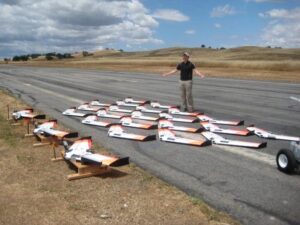 The US Naval Postgraduate School (NPS) Advanced Robotic Systems Engineering Laboratory (ARSENL) has announced that it has flown 50 autonomous UAVs, breaking their previous record of 30, during a field exercise at Camp Roberts.
The US Naval Postgraduate School (NPS) Advanced Robotic Systems Engineering Laboratory (ARSENL) has announced that it has flown 50 autonomous UAVs, breaking their previous record of 30, during a field exercise at Camp Roberts.
“I’m very proud of reaching our goal of successfully flying 50 autonomous UAVs simultaneously,” said NPS Assistant Professor Timothy Chung.
The 50 UAVs were launched and flown autonomously in two “sub-swarms” of 25 UAVs each and guided using ARSENL-developed swarm operator interfaces. The UAVs performed basic leader-follower cooperative behaviors and exchanged information amongst themselves via wireless links.
“This project came from the notion that quantity is a quality,” said Chung. “It’s like trying to play a game of tennis against an entire 5th grade class. If they were are all lobbing tennis balls across the court, it would be very hard to defend against them.”
In the past, each aircraft would be operated by a single person, which makes for a very large footprint with many moving parts.
“One of the ways we can mitigate that is transferring autonomy. These robots can make limited decisions … that will alleviate some of the pressure on our human operators,” said Chung. “Today, we were able to successfully control 50 UAVs with two operators that managed the aircraft’s behaviors and health.”
NPS Consortium for Robotics and Unmanned Systems Education and Research (CRUSER) Director Raymond R. Buettner is hopeful about this technology’s future applications.
“Twenty years from now when aerial swarms are routinely helping farmers improve their crops, helping rescuers locate lost children, and helping warfighters to win our nation’s wars, people will be able to look back at the efforts of NPS faculty and students in the skies over Camp Roberts as one of the seminal events that made such things possible,” he said.
Chung noted that ARSENL’s recent successes would not have been possible without the hard work and initiative of its systems engineering and cross-campus team members including NPS professors, Naval reservists, summer interns, NPS students and many more.


















